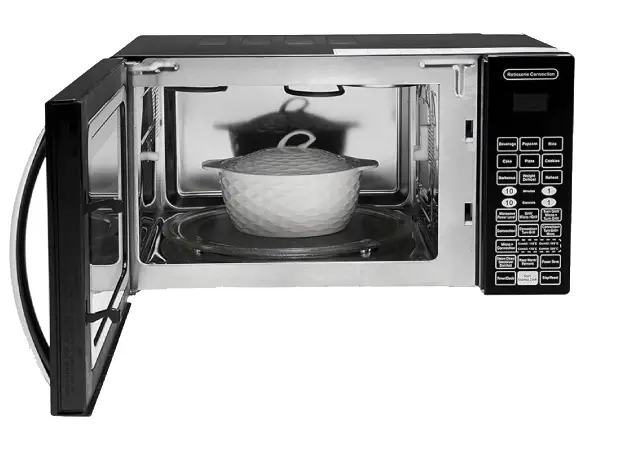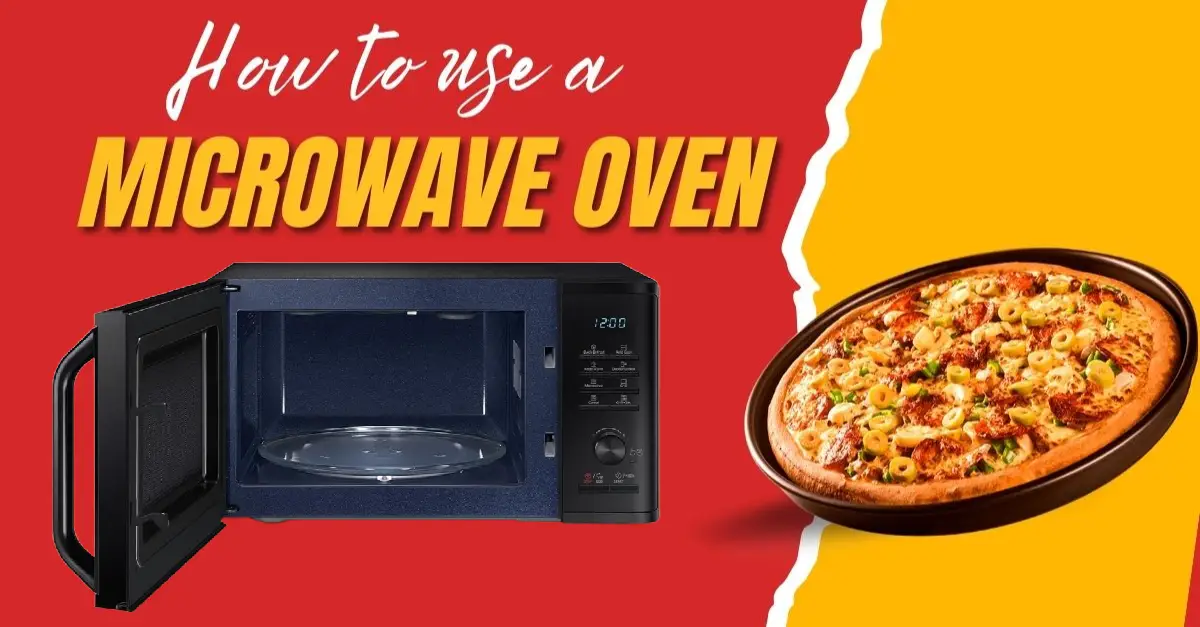Microwave ovens have changed the way we prepare and warm our food. They are convenient and efficient, saving us a lot of time in our daily lives.
If you are new to using it or you want to refresh your knowledge and skills about it, this guide will give you all the information that you need to know.
As a result, you will gain confidence in using your microwave oven safely and efficiently, thus making perfect foods every day. So, let’s get started!
Also, read this article – Solo vs Convection Microwave Oven.
Understanding the Basics of a How to Use a Microwave Oven.
What is a Microwave Oven and How Does It Work?

A microwave oven is an indispensable cooking appliance for the modern kitchen as it is used for cooking, reheating, and defrosting food items rapidly.
In operation, microwaves (a type of electromagnetic radiation) produced by it cause water molecules present in the food to vibrate thereby giving rise to heat which cooks such foods uniformly from their innermost parts.
Microwave Technology:
The magnetron forms the heart of a microwave oven which acts as an energy converter from electrical energy into microwave radiation.
These microwaves jump back and forth inside their metallic walls until they are absorbed by whatever is put into them to be cooked.
On top of that, the rotating turntable ensures even cooking while the control panel lets you select cook times as well as power levels used during cooking.
Cooking with a Microwave:
Microwaves use microwaves to heat food more quickly than conventional ovens that use convection or conduction.
They transmit the energy of microwaves into foods and thus cook food faster.
That is why it is possible to reheat leftovers, defrost frozen products, and prepare simple meals using a microwave.
Safety Precautions:
- Always go for microwaveable containers, glass, ceramics, or plastic containers that are safe to put in a microwave oven.
- Do not utilize utensils or metal dishes because they may spark and spoil the magnetron.
- To avoid destroying the magnetron, never run an empty microwave.
- Allow several minutes after you have heated your meal in the microwave before eating it so that heat can spread out evenly across food substances.
Also, read this article – LG 32L WiFi Enabled Charcoal Microwave Oven.
Step-by-Step Guide: How to Use a Microwave Oven
Step 1: Setting Up Your Microwave.
The first thing one has to do while starting to use a microwave oven is to ensure its proper installation.
Put your microwave on a flat surface that does not produce any heat.
A gap around the oven must be left for airflow; preferably at least 3 inches from each side and back.
- Microwave Placement: To avoid spillage when taking out hot items always set your microwave at chest level if possible. The power cord should be properly plugged into an earthed power outlet.
Step 2: Choosing the Right Cookware
Not all dishware can be used in microwaves. Selecting the wrong type may lead to cooking that is uneven or even dangerous.
- Microwave-Safe Containers: Look for “microwave-safe” on dishes. For the most part, these are glass and ceramics, but there are also plastics made specifically for microwave heating. If you are not sure, carry out a small test: put a cup of water in your container and place it in your microwave. Then set it on high for one minute. When the container does not turn hot but the water heats up, then you may use it.
- Don’t Use Metal or Foil: Arcing (sparks) and fire hazards are caused by metal containers and aluminum foil; hence they should never be used inside a microwave oven. Whenever you want to cover food, just find a microwave-safe lid, or perhaps as an alternative use a microwave-safe plastic wrap; however, remember to make a steam escape hole.
Step 3: Understanding the Control Panel.
Your control panel is the heart of your microwave oven; it’s where you input cook times, power levels, and special features.
- Power Levels: Many microwaves have power level adjustments. For instance, if you have 100% power this means that it is capable of making liquids hot as well as cooking dense foods such as meat better than any other setting can do. On the other hand, lower settings such as from 50% to 70 % will warm food gently or allow one to prepare more fragile foods.
- Timer Settings: To set the timer, you simply input the cooking time and press start. When in doubt, it is better to put in a shorter time and then add on more as needed so that you don’t overcook it.
- Preset Functions: There are many microwaves sold with preset functions for example “popcorn”, “defrost” or “pizza”.
These are handy options that select time and power level automatically according to food type, such as the defrosting function which often uses lower power to thaw frozen foods slowly without cooking them.
Quick Tips:
- Stir halfway through cooking to avoid uneven heating.
- Pause whenever necessary in order not to burn your food.
Step 4: Cooking and Reheating Food.
Microwave ovens can cook, warm up, and even defrost food; here’s how to use your microwave for different tasks:
- Reheating Leftovers: Place the food in a container that is safe for use in microwave ovens. Alternatively, a microwave-safe lid or damp paper towel can be used as coverings. Set the microwave at a medium (50%-70%) power level beginning with a moderate cooking duration. Stirring or turning the food halfway would ensure even heating.
- Cooking Fresh Food: You can use your microwave to steam, and cook vegetables and proteins or even rice. For example, when steaming vegetables, put a little water in the container. Put a microwave-safe lid on it and use high heat to cook for several minutes until done.
- Defrosting Frozen Food: Using the defrost function or setting your microwave oven at a lower power level (30%-50%) would do. Enter the weight of the food if prompted, and start the defrost cycle. Make sure to check on it often to prevent it from starting to cook.
- Microwave Recipes: Several recipe books on how you can make cake in a mug, scrambled eggs, and even microwaved potatoes are available out there specifically made for microwave cooking. These are fast, effortless meals that will come in handy any time you are out of time.
Tip: When reheating liquids like soups or beverages microwave-safe covers should be used to avoid ballooning splatters. For foods requiring crispiness, consider using a microwave crisper tray.
Step 5: Cleaning and Maintenance.
Taking care of your microwave well enough will result in its efficiency as well as extending its life span.
- Daily Cleaning: Following every single use, wipe the inside of the microwave to remove food splatters. Use a wet cloth or sponge with mild soap. For those stubborn stains, put water in a bowl and cook it for some minutes with some slices of lemon or a little bit of vinegar. The steam will make the dirt loose so that you can easily clean it.
- Deep Cleaning: At least once during seven days, remove the turntable and wash it in warm, soapy water. Clean the outside of the microwave together with its control panel using a moistened cloth. Do not apply harsh chemicals or hard substances as they might damage the surface.
Microwave Cleaning Tips:
- Steam clean the insides by using a microwave-safe bowl containing water and lemon juice.
- Never use metal scouring pads on interior surfaces as they may scrape them.
- Ensure proper airflow by regularly checking and cleaning your microwave’s vents.
Maintenance Tips:
- Periodically inspect your microwave’s door seal to ascertain that it is properly closed without any radiation leakage.
- Replace this every six months to one year if your device has a charcoal filter(e.g. over-the-range models).
- Keep an ear out for strange sounds when the machine is running as they may indicate a malfunction. If you hear any, it could be time to contact a repairman.
Also, read this article – Top Amazing Reasons to Choose the Samsung 28L Convection Microwave Oven for Your Kitchen!
Common Mistakes to Avoid When Using a Microwave Oven.
While it might be said that the use of a microwave is self-explanatory, some common mistakes can result in negative consequences or even safety issues. See below for them.
#1. Using Metal Containers:
As already stated earlier, metal in the microwave can cause sparks and fire. Always choose containers labeled as “microwave safe.”
#2. Overcooking Food:
Microwaves cook fast so things can easily go wrong. Begin with less cooking time and regularly inspect the food. Overcooked food tends to be dry, tough, or charred.
#3. Not Stirring Food:
While cooking, microwaves may heat food unevenly; thus stirring halfway through ensures that heat is spread evenly across all parts of the food being prepared especially if it is a thick one like stews or casseroles.
#4. Ignoring Standing Time:
After microwaving, food keeps on cooking for several minutes due to residual heating. For this reason, leaving your meal to rest for a few moments helps in equalizing temperatures such that it becomes fully cooked.
#5. Using the Microwave Empty:
The machine may be damaged by running an empty microwave without any content inside it at all e.g., no water and no foodstuffs put in it. There is nothing for microwaves to absorb and hence they may result in overheating and magnetron failure
#6. Food is not being covered:
When reheating food, you should always put a microwave-safe lid or a moist paper towel on it; this helps keep moisture inside and prevents the microwave from making unseat splatters.
#7. Not Cleaning Regularly:
A dirty microwave may carry bacteria and result in an unpleasant smell. It is mandatory to clean your microwave regularly to maintain its hygiene as well as its normal functioning.
#8. Using the Wrong Cookware:
Not all cookware can be used with microwaves safely. Always check for ‘microwave-safe’ on the container before using it.
Also, read this article – How to Clean a Microwave Oven
FAQs
Can I put any plastic container in the microwave?
No, not all plastic containers are safe for the microwave. Use only those indicated “microwave-safe.” Others could melt, buckle or release toxic substances when heated.
How can I tell if my food is properly cooked?
Check the internal temperature of food by using a food thermometer most foods need an internal temperature of at least 165°F (74°C) to be considered safe for consumption. Stirring it through and allowing some time before taking it off ensures that it has cooked evenly after micro-waving also helps achieve balance while cooking unlike just heating up.
What is the best way to clean a microwave oven?
To maintain cleanliness in a microwave, one has to wipe it with a wet cloth anytime they use it. For more extensive cleaning of the grime, you can put water with lemon slices or vinegar in a bowl and heat it up for some minutes to create steam. Next, clean the inside using a soft fabric.
Can I defrost meat in a microwave?
Sure! You can defrost meat in a microwave by either using the “defrost” function or setting it to a low power (30% – 50%) so that it warms slowly. It is advisable to regularly check it for doneness otherwise you’ll end up cooking it. Make sure also that you flip the meat halfway through.
Conclusion.
Microwaving is an easy and effective means of cooking, but knowing how to use a microwave oven properly will determine your final results.
This guide has given all the information required for choosing appropriate cookware, understanding control panel functionality, avoiding common mistakes, etc.
Furthermore, make sure you always observe safety rules as well as clean your appliance on time while exploiting its all-inclusive features.
If you like this article, share it with your relatives and friends and comment below.










